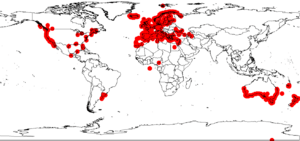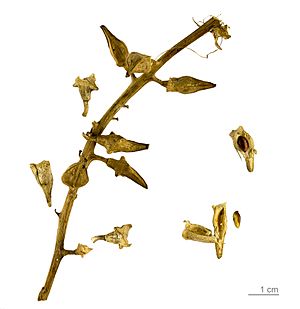European searocket facts for kids
Quick facts for kids European searocket |
|
|---|---|
 |
|
| Scientific classification | |
| Genus: |
Cakile
|
| Species: |
maritima
|
 |
|
| Occurrence data from GBIF | |
The Cakile maritima, also known as the European searocket, is a common plant. It belongs to the mustard family. You can find it widely across Europe, North Africa, and western Asia. It especially likes to grow along coastlines.
This plant has also spread to many other parts of the world. It grows on the west and east coasts of North America. Here, it can sometimes become a problem plant. The European searocket is an annual plant, meaning it lives for only one year. It grows in clumps or mounds in the sand on beaches and cliffs. Its shiny leaves are thick and green, often with hints of purple. The plant has white to light purple flowers. It also produces unique, corky brown fruits. These fruits can float, helping their seeds spread by water.
Contents
What Does European Searocket Look Like?
The European searocket is a smooth, juicy plant. It lives for about one year. It has a main root that can be thin or thick. Its stem branches out and can grow flat on the ground or reach upwards. It usually grows to be about 15 to 45 centimeters (6 to 18 inches) tall.
The leaves are thick and grow spaced out along the stem. The lower leaves are shaped like an egg or a spear. The upper leaves are more oblong. In the UK, this plant blooms between June and August. Its small flowers are white, lilac, or purple. Each flower has four petals and can be up to 25 millimeters (about 1 inch) wide.
After flowering, the plant makes green seed pods. These pods turn brown as they get older. They are short and stubby. Inside, each pod holds two smooth, yellow or brown seeds. The oil in these seeds contains something called erucic acid.
How It Handles Pollution
The European searocket is very good at protecting itself. It has a strong system that helps it fight off damage. This means it can survive even in places with high levels of pollution. It can even handle heavy metals like Cadmium.
Naming the European Searocket
The European searocket was first officially described in 1772. This was done by a scientist named Giovanni Antonio Scopoli. He published his description in a book called 'Fl. Carniol.'
The second part of its scientific name, maritima, comes from a Latin word. It means 'of the sea'. This name makes sense because the plant often grows near the ocean.
Sometimes, you might hear about a slightly different type of this plant. It's called Cakile maritima subsp. baltica. This is a subspecies, which is like a special group within the main species.
Where European Searocket Grows

The European searocket is originally from places with mild climates. These include parts of North Africa, western Asia, and Europe.
Its Home Countries
In Africa, you can find it in Algeria, the Canary Islands, Egypt, Libya, the Madeira Islands, Morocco, and Tunisia.
In Western Asia, it grows in the Caucasus region, Georgia, Iran, Israel, Syria, and Turkey. In Eastern Europe, it's in Estonia and Ukraine. In Central Europe, it's found in Belgium, Germany, the Netherlands, and Poland.
In Northern Europe, it grows in Denmark, Finland, Iceland, Norway, and the United Kingdom. In Southeastern Europe, you can find it in Albania, Bulgaria, Croatia, Greece, Italy, Montenegro, Romania, Serbia, and Slovenia. In Southwestern Europe, it's in France, Portugal, and Spain.
It has also spread and now grows wild in many places outside its original home. This includes North America.
Where It Likes to Live
This plant loves to grow on beaches. It's often found near large sand dunes and on rocky shores. It can handle salty sea spray. It also doesn't mind if seawater washes over it for a short time.
Many different insects help to pollinate the European searocket. These include the honey bee, a type of hoverfly called Eristalis intricarius, and the cabbage white butterfly, Pieris rapae.
Why It Matters to Animals
The seeds of the European searocket contain a lot of erucic acid. This acid can sometimes affect the heart muscle of certain animals.
However, the orange-bellied parrot actually eats these seeds. They feed on them during their long journey. These parrots migrate north from Tasmania and Australia.
How People Use It
The leaves of the European searocket are edible. It's usually better to cook them before eating. However, you shouldn't eat too many of them. The oil from the seeds can also be used for industrial purposes.
Images for kids
See also
 In Spanish: Oruga de mar para niños
In Spanish: Oruga de mar para niños



